Nissan XTrail T30 2006 User Manual

J AIR CONDITIONER
SECTION MTC
MANUAL AIR CONDITIONER
A
B
C
D
CONTENTS
E
PRECAUTIONS ......................................................... |
4 |
Precautions for Supplemental Restraint System |
|
(SRS) “AIR BAG” and “SEAT BELT PRE-TEN- |
|
SIONER” ................................................................. |
4 |
Precautions for Working with HFC-134a (R-134a)..... |
4 |
CONTAMINATED REFRIGERANT ...................... |
5 |
General Refrigerant Precautions ............................. |
5 |
Precautions for Refrigerant Connection .................. |
6 |
FEATURES OF NEW TYPE REFRIGERANT |
|
CONNECTION ..................................................... |
6 |
O-RING AND REFRIGERANT CONNECTION..... |
7 |
Precautions for Servicing Compressor .................... |
9 |
Precautions for Service Equipment ......................... |
9 |
RECOVERY/RECYCLING EQUIPMENT ............. |
9 |
ELECTRICAL LEAK DETECTOR ........................ |
9 |
VACUUM PUMP .................................................. |
9 |
MANIFOLD GAUGE SET ..................................... |
9 |
SERVICE HOSES .............................................. |
10 |
SERVICE COUPLERS ....................................... |
10 |
REFRIGERANT WEIGHT SCALE ..................... |
10 |
CHARGING CYLINDER ..................................... |
10 |
Precautions for Leak Detection Dye ...................... |
10 |
IDENTIFICATION ................................................ |
11 |
IDENTIFICATION LABEL FOR VEHICLE ........... |
11 |
PREPARATION ........................................................ |
12 |
Special Service Tools ............................................ |
12 |
HFC-134a (R-134a) Service Tools and Equipment... |
13 |
Commercial Service Tools ..................................... |
15 |
REFRIGERATION SYSTEM .................................... |
16 |
Refrigerant Cycle .................................................. |
16 |
REFRIGERANT FLOW ...................................... |
16 |
FREEZE PROTECTION .................................... |
16 |
Refrigerant System Protection .............................. |
16 |
REFRIGERANT PRESSURE SENSOR ............ |
16 |
PRESSURE RELIEF VALVE .............................. |
16 |
V-6 Variable Displacement Compressor ................ |
17 |
GENERAL INFORMATION ................................ |
17 |
DESCRIPTION ................................................... |
18 |
Component Layout ................................................ |
21 |
LUBRICANT ............................................................. |
22 |
Maintenance of Lubricant Quantity in Compressor... 22 |
|
LUBRICANT ....................................................... |
22 |
LUBRICANT RETURN OPERATION ................. |
22 |
LUBRICANT ADJUSTING PROCEDURE FOR |
|
COMPONENTS REPLACEMENT EXCEPT |
|
COMPRESSOR ................................................. |
23 |
LUBRICANT ADJUSTING PROCEDURE FOR |
|
COMPRESSOR REPLACEMENT ...................... |
23 |
AIR CONDITIONER CONTROL .............................. |
25 |
Control Operation .................................................. |
25 |
FAN CONTROL DIAL ......................................... |
25 |
TEMPERATURE CONTROL DIAL ..................... |
25 |
MODE CONTROL DIAL ..................................... |
25 |
RECIRCULATION (REC) SWITCH .................... |
25 |
A/C SWITCH ...................................................... |
25 |
Discharge Air Flow ................................................. |
26 |
System Description ................................................ |
27 |
SWITCHES AND THEIR CONTROL FUNCTION... 27 |
|
TROUBLE DIAGNOSIS ........................................... |
28 |
How to Perform Trouble Diagnoses for Quick and |
|
Accurate Repair ..................................................... |
28 |
WORK FLOW ..................................................... |
28 |
SYMPTOM TABLE ............................................. |
28 |
ComponentPartsandHarnessConnectorLocation... 29 |
|
ENGINE COMPARTMENT ................................. |
29 |
PASSENGER COMPARTMENT ........................ |
30 |
Schematic — A/C, M — ....................................... |
... 31 |
Wiring Diagram — A/C, M — ............................... |
... 32 |
Operational Check ................................................. |
36 |
CHECKING BLOWER ........................................ |
36 |
CHECKING DISCHARGE AIR ........................... |
36 |
CHECKING INTAKE AIR .................................... |
36 |
CHECKING TEMPERATURE DECREASE ........ |
36 |
CHECKING TEMPERATURE INCREASE ......... |
36 |
CHECKING A/C SWITCH .................................. |
36 |
Mode Door ............................................................. |
37 |
INSPECTION FLOW .......................................... |
37 |
Air Mix Door ........................................................... |
38 |
INSPECTION FLOW ........................................ |
|
F
G
H
I
MTC
K
L
M
Revision: 2006 July |
MTC-1 |
2006 X-Trail |

Intake Door Motor Circuit ....................................... |
39 |
INSPECTION FLOW .......................................... |
39 |
COMPONENT DESCRIPTION ........................... |
39 |
DIAGNOSISPROCEDUREFORINTAKEDOOR |
|
MOTOR .............................................................. |
40 |
Blower Motor Circuit .............................................. |
42 |
INSPECTION FLOW .......................................... |
42 |
DIAGNOSIS PROCEDURE FOR BLOWER |
|
MOTOR .............................................................. |
42 |
COMPONENT INSPECTION ............................. |
45 |
Magnet Clutch Circuit ............................................ |
46 |
INSPECTION FLOW .......................................... |
46 |
DIAGNOSIS PROCEDURE FOR MAGNET |
|
CLUTCH ............................................................. |
47 |
ELECTRICAL COMPONENT INSPECTION ...... |
51 |
Insufficient Cooling ................................................ |
52 |
INSPECTION FLOW .......................................... |
52 |
PERFORMANCE TEST DIAGNOSIS ................ |
54 |
PERFORMANCE CHART .................................. |
56 |
TROUBLE DIAGNOSIS FOR UNUSUAL PRES- |
|
SURE .................................................................. |
57 |
Insufficient Heating ................................................ |
60 |
INSPECTION FLOW .......................................... |
60 |
Noise ..................................................................... |
61 |
INSPECTION FLOW .......................................... |
61 |
CONTROLLER .......................................................... |
62 |
Removal and Installation of Heater Control Panel... |
62 |
REMOVAL .......................................................... |
62 |
INSTALLATION ................................................... |
62 |
Disassembly and Assembly ................................... |
62 |
BLOWER UNIT ........................................................ |
63 |
Removal and Installation ....................................... |
63 |
REMOVAL .......................................................... |
63 |
INSTALLATION ................................................... |
63 |
Disassembly and Assembly ................................... |
64 |
BLOWER MOTOR ................................................... |
65 |
Removal and Installation ....................................... |
65 |
REMOVAL .......................................................... |
65 |
INSTALLATION ................................................... |
65 |
INTAKE DOOR MOTOR .......................................... |
66 |
Removal and Installation ....................................... |
66 |
REMOVAL .......................................................... |
66 |
INSTALLATION ................................................... |
66 |
BLOWER FAN RESISTOR ...................................... |
67 |
Removal and Installation ....................................... |
67 |
REMOVAL .......................................................... |
67 |
INSTALLATION ................................................... |
67 |
IN-CABIN MICROFILTER ........................................ |
68 |
Removal and Installation ....................................... |
68 |
FUNCTION ......................................................... |
68 |
REPLACEMENT TIMING ................................... |
68 |
REPLACEMENT PROCEDURES ...................... |
68 |
HEATER & COOLING UNIT ASSEMBLY ................ |
69 |
Removal and Installation ....................................... |
69 |
REMOVAL .......................................................... |
69 |
INSTALLATION ................................................... |
70 |
Disassembly and Assembly ................................... |
71 |
MODE DOOR ........................................................... |
72 |
Mode Door Cable Adjustment ............................... |
72 |
AIR MIX DOOR ......................................................... |
73 |
Air Mix Door Cable Adjustment .............................. |
73 |
HEATER CORE ........................................................ |
74 |
Removal and Installation ........................................ |
74 |
REMOVAL ........................................................... |
74 |
INSTALLATION ................................................... |
74 |
DUCTS AND GRILLES ............................................ |
75 |
Removal and Installation ........................................ |
75 |
REMOVAL ........................................................... |
75 |
INSTALLATION ................................................... |
78 |
REFRIGERANT LINES ............................................ |
79 |
HFC-134a (R-134a) Service Procedure ................. |
79 |
SETTING OF SERVICE TOOLS AND EQUIP- |
|
MENT .................................................................. |
79 |
Components ........................................................... |
81 |
Removal and Installation of Compressor ............... |
81 |
REMOVAL ........................................................... |
81 |
INSTALLATION ................................................... |
82 |
Removal and Installation of Compressor Clutch .... |
83 |
REMOVAL ........................................................... |
83 |
INSTALLATION ................................................... |
85 |
Removal and Installation of Low-pressure Flexible |
|
Hose ....................................................................... |
86 |
REMOVAL ........................................................... |
86 |
INSTALLATION ................................................... |
86 |
Removal and Installation of High-pressure Flexible |
|
Hose ....................................................................... |
87 |
REMOVAL ........................................................... |
87 |
INSTALLATION ................................................... |
87 |
Removal and Installation of High-pressure Pipe .... |
87 |
REMOVAL ........................................................... |
87 |
INSTALLATION ................................................... |
88 |
Removal and Installation of Condenser ................. |
88 |
REMOVAL ........................................................... |
88 |
INSTALLATION ................................................... |
89 |
Removal and Installation of Liquid Tank ................ |
89 |
REMOVAL ........................................................... |
89 |
INSTALLATION ................................................... |
89 |
Removal and Installation for Refrigerant Pressure |
|
Sensor .................................................................... |
90 |
REMOVAL ........................................................... |
90 |
INSTALLATION ................................................... |
90 |
Removal and Installation of Evaporator ................. |
90 |
REMOVAL ........................................................... |
90 |
INSTALLATION ................................................... |
91 |
Removal and Installation of Expansion Valve ........ |
91 |
REMOVAL ........................................................... |
91 |
INSTALLATION ................................................... |
91 |
Checking for Refrigerant Leaks ............................. |
91 |
Checking System for Leaks Using the Fluorescent |
|
Leak Detector ......................................................... |
92 |
Dye Injection .......................................................... |
92 |
Electrical Leak Detector ......................................... |
92 |
PRECAUTIONS FOR HANDLING LEAK |
|
DETECTOR ........................................................ |
92 |
CHECKING PROCEDURE ................................. |
93 |
SERVICE DATA AND SPECIFICATIONS (SDS) .....95 |
|
Compressor ........................................................... |
95 |
Lubricant ................................................................ |
95 |
Revision: 2006 July |
MTC-2 |
2006 X-Trail |

Refrigerant ............................................................ |
95 |
Engine Idling Speed .............................................. |
95 |
|
|
Belt Tension ........................................................... |
95 |
A
B
C
D
E
F
G
H
I
MTC
K
L
M
Revision: 2006 July |
MTC-3 |
2006 X-Trail |
|
PRECAUTIONS |
|
|
PRECAUTIONS |
PFP:00001 |
Precautions for Supplemental Restraint System (SRS) “AIR BAG” and “SEAT BELT PRE-TENSIONER” AJS001M5
The Supplemental Restraint System such as “AIR BAG” and “SEAT BELT PRE-TENSIONER”, used along with a front seat belt, helps to reduce the risk or severity of injury to the driver and front passenger for certain types of collision. Information necessary to service the system safely is included in the SRS and SB section of this Service Manual.
WARNING:
●To avoid rendering the SRS inoperative, which could increase the risk of personal injury or death in the event of a collision which would result in air bag inflation, all maintenance must be performed by an authorized NISSAN/INFINITI dealer.
●Improper maintenance, including incorrect removal and installation of the SRS, can lead to personal injury caused by unintentional activation of the system. For removal of Spiral Cable and Air Bag Module, see the SRS section.
●Do not use electrical test equipment on any circuit related to the SRS unless instructed to in this Service Manual. SRS wiring harnesses can be identified by yellow and/or orange harnesses or harness connectors.
Precautions for Working with HFC-134a (R-134a) |
AJS001OH |
CAUTION:
●CFC-12 (R-12) refrigerant and HFC-134a (R-134a) refrigerant are not compatible. If the refrigerants are mixed and compressor malfunction is likely to occur, refer to “CONTAMINATED REFRIGERANT” below. To determine the purity of HFC-134a (R-134a) in the vehicle and recovery tank, use Refrigerant Recovery/Recycling Recharging equipment and Refrigerant Identifier.
●Use only specified lubricant for the HFC-134a (R-134a) A/C system and HFC-134a (R-134a) components. If lubricant other than that specified is used, compressor malfunction is likely to occur.
●The specified HFC-134a (R-134a) lubricant rapidly absorbs moisture from the atmosphere. The following handling precautions must be observed:
–When removing refrigerant components from a vehicle, immediately cap (seal) the component to minimize the entry of moisture from the atmosphere.
–When installing refrigerant components to a vehicle, never remove the caps (unseal) until just before connecting the components. Connect all refrigerant loop components as quickly as possible to minimize the entry of moisture into system.
–Only use the specified lubricant from a sealed container. Immediately reseal containers of lubricant. Without proper sealing, lubricant will become moisture saturated and should not be used.
–Never allow lubricant (Nissan A/C System Oil Type S) to come in contact with styrene foam parts. Damage may result.
Revision: 2006 July |
MTC-4 |
2006 X-Trail |

PRECAUTIONS
CONTAMINATED REFRIGERANT
If a refrigerant other than pure HFC-134a (R-134a) is identified in a vehicle, take appropriate steps A shown below:
●Explain to the customer that environmental regulations prohibit the release of contaminated refrigerant
into the atmosphere. |
B |
●Explain that recovery of the contaminated refrigerant could damage service equipment and refrigerant supply.
● Suggest the customer return the vehicle to the location of previous service where the contamination may have occurred.
● In case of repairing, recover the refrigerant using only dedicated equipment and containers. Never recover contaminated refrigerant into the existing service equipment. If the facility does not have dedicated recovery equipment, contact a local refrigerant product retailer for available service. This refrigerant must be disposed of in accordance with all federal and local regulations. In addition, replacement of all refrigerant system components on the vehicle is recommended.
●If the vehicle is within the warranty period, the air conditioner warranty is void. Please contact Nissan Customer Affairs for further assistance.
General Refrigerant Precautions |
AJS001M7 |
WARNING:
●Avoid breathing A/C refrigerant and lubricant vapor or mist. Exposure may irritate eyes, nose and
throat. Remove HFC-134a (R-134a) from the A/C system, using certified service equipment meeting requirements of SAE J-2210 [HFC-134a (R-134a) recycling equipment], or J-2209 [HFC-134a (R- 134a) recovery equipment]. If accidental system discharge occurs, ventilate work area before resuming service. Additional health and safety information may be obtained from refrigerant and lubricant manufacturers.
●Never release refrigerant into the air. Use approved recovery/recycling equipment to capture the refrigerant every time an air conditioning system is discharged.
●Always wear eye and hand protection (goggles and gloves) when working with any refrigerant or air conditioning system.
●Never store or heat refrigerant containers above 52° C (126° F).
●Never heat a refrigerant container with an open flame; if container warming is required, place the bottom of the container in a warm pail of water.
●Never intentionally drop, puncture, or incinerate refrigerant containers.
●Keep refrigerant away from open flames: poisonous gas will be produced if refrigerant burns.
●Refrigerant will displace oxygen, therefore be certain to work in well ventilated areas to prevent
suffocation.
●Never pressure test or leak test HFC-134a (R-134a) service equipment and/or vehicle air conditioning systems with compressed air during repair. Some mixtures of air and HFC-134a (R-134a) have been shown to be combustible at elevated pressures. These mixtures, if ignited, may cause injury
or property damage. Additional health and safety information may be obtained from refrigerant manufacturers.
C
D
E
F
G
H
I
MTC
K
L
M
Revision: 2006 July |
MTC-5 |
2006 X-Trail |

PRECAUTIONS
Precautions for Refrigerant Connection |
AJS001M9 |
A new type refrigerant connection has been introduced to all refrigerant lines except the following location.
●Expansion valve to evaporator
●Refrigerant pressure sensor to liquid tank
FEATURES OF NEW TYPE REFRIGERANT CONNECTION
●The O-ring has been relocated. It has also been provided with a groove for proper installation. This eliminates the possibility of the O-ring being caught in, or damaged by, the mating part. The sealing direction of the O-ring is now set vertically in relation to the contacting surface of the mating part to improve sealing characteristics.
●The reaction force of the O-ring will not occur in the direction that causes the joint to pull out, thereby facilitating piping connections.
SHA815E
Revision: 2006 July |
MTC-6 |
2006 X-Trail |
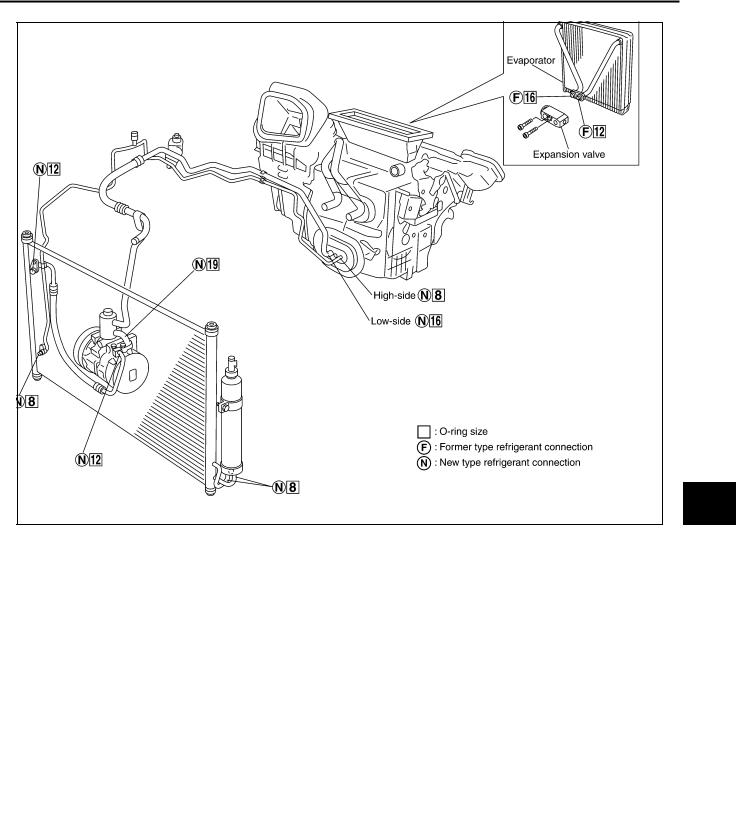
PRECAUTIONS
O-RING AND REFRIGERANT CONNECTION
RJIA3160E
CAUTION:
The new and former refrigerant connections use different O-ring configurations. Never confuse O- rings since they are not interchangeable. If a wrong O-ring is installed, refrigerant may leak at the connection.
A
B
C
D
E
F
G
H
I
MTC
K
O-Ring Part Numbers and Specifications
|
Connec- |
|
O-ring |
Part number |
D mm (in) |
W mm (in) |
|
tion type |
|
size |
|||
|
|
|
|
|
||
|
|
|
|
|
|
|
|
New |
|
8 |
92471 N8210 |
6.80 (0.2680) |
1.85 (0.0728) |
|
|
|
|
|
|
|
|
Former |
|
92470 N8200 |
6.07 (0.2390) |
1.78 (0.0701) |
|
|
|
|
||||
|
|
|
|
|
|
|
|
Former |
10 |
J2476 89956 |
9.25 (0.3642) |
1.78 (0.0701) |
|
|
|
|
|
|
|
|
|
New |
|
12 |
92472 N8210 |
10.90 (0.429) |
2.43 (0.0957) |
|
|
|
|
|
|
|
|
Former |
|
92475 71L00 |
11.00 (0.433) |
2.40 (0.0940) |
|
|
|
|
||||
|
|
|
|
|
|
|
|
New |
|
16 |
92473 N8210 |
13.60 (0.535) |
2.43 (0.0957) |
|
|
|
|
|
|
|
|
Former |
|
92475 72L00 |
14.30 (0.563) |
2.30 (0.0910) |
|
|
|
|
||||
|
|
|
|
|
|
|
SHA814E |
New |
|
19 |
92474 N8210 |
16.50 (0.650) |
2.43 (0.0957) |
|
|
|
|
|
|
|
|
Former |
|
92477 N8200 |
17.12 (0.674) |
1.78 (0.0701) |
|
|
|
|
||||
|
|
|
|
|
|
|
WARNING:
Make sure all refrigerant is discharged into the recycling equipment and the pressure in the system is less than atmospheric pressure. Then gradually loosen the discharge side hose fitting and remove it.
CAUTION:
When replacing or cleaning refrigerant cycle components, observe the following.
L
M
Revision: 2006 July |
MTC-7 |
2006 X-Trail |

PRECAUTIONS
●When the compressor is removed, store it in the same way at it is when mounted on the car. Failure to do so will cause lubricant to enter the low-pressure chamber.
●When connecting tubes, always use a torque wrench and a back-up wrench.
●After disconnecting tubes, immediately plug all openings to prevent entry of dust and moisture.
●When installing an air conditioner in the vehicle, connect the pipes at the final stage of the operation. Never remove the seal caps of pipes and other components until just before required for connection.
●Allow components stored in cool areas to warm to working area temperature before removing seal caps. This prevents condensation from forming inside A/C components.
●Thoroughly remove moisture from the refrigeration system before charging the refrigerant.
●Always replace used O-rings.
●When connecting tubes, apply lubricant to circle of the O-rings shown in illustration. Be careful not to apply lubricant to threaded portion.
Name |
: Nissan A/C System Oil Type S |
●O-ring must be closely attached to the groove of tube.
●When replacing the O-ring, be careful not to damage O-ring and tube.
●Connect tube until a click can be heard, then tighten the nut or bolt by hand. Make sure that the O- ring is installed to tube correctly.
●After connecting line, perform leak test and make sure that there is no leakage from connections. When the refrigerant leaking point is found, disconnect that line and replace the O-ring. Then tighten connections of seal seat to the specified torque.
RHA861F
Revision: 2006 July |
MTC-8 |
2006 X-Trail |
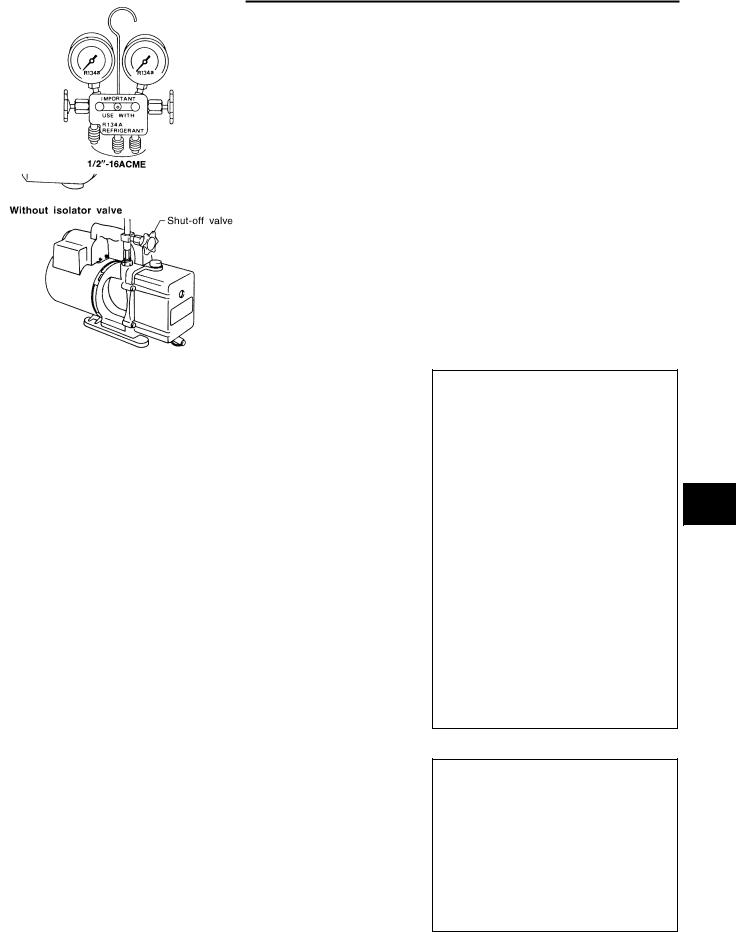
PRECAUTIONS
Precautions for Servicing Compressor |
AJS001MA |
●Plug all openings to prevent moisture and foreign matter from entering.
●When the compressor is removed, store it in the same way at it is when mounted on the car.
●When replacing or repairing compressor, follow “Maintenance of Lubricant Quantity in Compressor” exactly. Refer to MTC-22, "Maintenance of Lubricant Quantity in Compressor" .
●Keep friction surfaces between clutch and pulley clean. If the surface is contaminated with lubricant, wipe it off by using a clean waste cloth moistened with thinner.
●After compressor service operation, turn the compressor shaft by hand more than five turns in both directions. This will equally distribute lubricant inside the compressor. After the compressor is installed, let the engine idle and operate the compressor for one hour.
●After replacing the compressor magnet clutch, apply voltage to the new one and check for normal operation.
A
B
C
D
Precautions for Service Equipment |
AJS001MB |
RECOVERY/RECYCLING EQUIPMENT
Be certain to follow the manufacturer’s instructions for machine operation and machine maintenance. Never introduce any refrigerant other than that specified into the machine.
ELECTRICAL LEAK DETECTOR
Be certain to follow the manufacturer’s instructions for tester operation and tester maintenance.
VACUUM PUMP
The lubricant contained inside the vacuum pump is not compatible with the specified lubricant for HFC-134a (R-134a) A/C systems. The vent side of the vacuum pump is exposed to atmospheric pressure. So the vacuum pump lubricant may migrate out of the pump into the service hose. This is possible when the pump is switched off after evacuation (vacuuming) and hose is connected to it.
To prevent this migration, use a manual valve placed near the hose- to-pump connection, as follows.
●Usually vacuum pumps have a manual isolator valve as part of the pump. Close this valve to isolate the service hose from the pump.
●For pumps without an isolator, use a hose equipped with a manual shut-off valve near the pump end. Close the valve to isolate the hose from the pump.
●If the hose has an automatic shut-off valve, disconnect the hose from the pump. As long as the hose is connected, the valve is open and lubricating oil may migrate.
Some one-way valves open when vacuum is applied and close under no vacuum condition. Such valves may restrict the pump’s ability to pull a deep vacuum and are not recommended.
RHA270DA
MANIFOLD GAUGE SET
Be certain that the gauge face indicates HFC-134a or R-134a. Be sure the gauge set has 1/2″ -16 ACME threaded connections for service hoses. Confirm the set has been used only with refrigerant HFC-134a (R-134a) and specified lubricants.
SHA533D
E
F
G
H
I
MTC
K
L
M
Revision: 2006 July |
MTC-9 |
2006 X-Trail |

PRECAUTIONS
SERVICE HOSES
Be certain that the service hoses display the markings described (colored hose with black stripe). All hoses must include positive shutoff devices (either manual or automatic) near the end of the hoses opposite the manifold gauge.
SERVICE COUPLERS
Never attempt to connect HFC-134a (R-134a) service couplers to a CFC-12 (R-12) A/C system. The HFC-134a (R-134a) couplers will not properly connect to the CFC-12 (R-12) system. However, if an improper connection is attempted, discharging and contamination may occur.
Shut-off valve rotation |
A/C service valve |
|
|
Clockwise |
Open |
|
|
Counterclockwise |
Close |
|
|
REFRIGERANT WEIGHT SCALE
Verify that no refrigerant other than HFC-134a (R-134a) and specified lubricants have been used with the scale. If the scale controls refrigerant flow electronically, the hose fitting must be 1/2″ -16 ACME.
RHA272D
RHA273D
RHA274D
CHARGING CYLINDER
Using a charging cylinder is not recommended. Refrigerant may be vented into air from cylinder’s top valve when filling the cylinder with refrigerant. Also, the accuracy of the cylinder is generally less than that of an electronic scale or of quality recycle/recharge equipment.
Precautions for Leak Detection Dye |
AJS001MC |
●The A/C system contains a fluorescent leak detection dye used for locating refrigerant leaks. An ultraviolet (UV) lamp is required to illuminate the dye when inspecting for leaks.
●Always wear fluorescence enhancing UV safety goggles to protect your eyes and enhance the visibility of the fluorescent dye.
●The fluorescent dye leak detector is not a replacement for an electrical leak detector (SST: J-41995). The fluorescent dye leak detector should be used in conjunction with an electrical leak detector (SST: J-41995) to pin-point refrigerant leaks.
●For the purpose of safety and customer’s satisfaction, read and follow all manufacture’s operating instructions and precautions prior to performing the work.
●A compressor shaft seal should not necessarily be repaired because of dye seepage. The compressor shaft seal should only be repaired after confirming the leak with an electrical leak detector (SST: J-41995).
●Always remove any remaining dye from the leak area after repairs are completed to avoid a misdiagnosis during a future service.
Revision: 2006 July |
MTC-10 |
2006 X-Trail |

PRECAUTIONS
●Never allow dye to come into contact with painted body panels or interior components. If dye is spilled,
clean immediately with the approved dye cleaner. Fluorescent dye left on a surface for an extended period of time cannot be removed.
●Never spray the fluorescent dye cleaning agent on hot surfaces (engine exhaust manifold, etc.).
● |
Never use more than one refrigerant dye bottle (1/4 ounce /7.4 cc) per A/C system. |
● |
Leak detection dyes for HFC-134a (R-134a) and CFC-12 (R-12) A/C systems are different. Never use |
|
HFC-134a (R-134a) leak detection dye in CFC-12 (R-12) A/C system, or CFC-12 (R-12) leak detection |
|
dye in HFC-134a (R-134a) A/C system, or A/C system damage may result. |
●The fluorescent properties of the dye will remain for three years or a little over unless a compressor malfunction occurs.
A
B
C
IDENTIFICATION |
D |
NOTE: |
|
Vehicles with factory installed fluorescent dye have a green label. |
|
Vehicles without factory installed fluorescent dye have a blue label. |
E |
IDENTIFICATION LABEL FOR VEHICLE |
|
Vehicles with factory installed fluorescent dye have the identification label on the front side of hood. |
F |
|
|
|
G |
|
H |
|
I |
|
|
|
MTC |
|
|
|
K |
|
L |
|
M |
Revision: 2006 July |
MTC-11 |
2006 X-Trail |
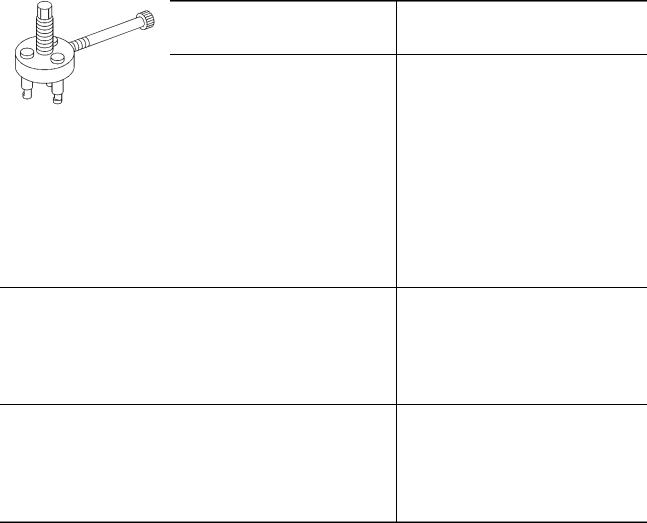
|
PREPARATION |
|
|
PREPARATION |
PFP:00002 |
Special Service Tools |
AJS001O8 |
The actual shapes of Kent-Moore tool may differ from those of special service tools illustrated here.
Tool number
(Kent-Moore No.) Description Tool name
KV99106100
(J-41260) S-NT232 Removing shaft nut and clutch disc Clutch disc wrench
SJIA1168E
KV99232340
(J-38874) Removing clutch disc Clutch disc puller
S-NT376
KV99106200
(J-41261) Installing pulley Pulley installer
S-NT235
Revision: 2006 July |
MTC-12 |
2006 X-Trail |
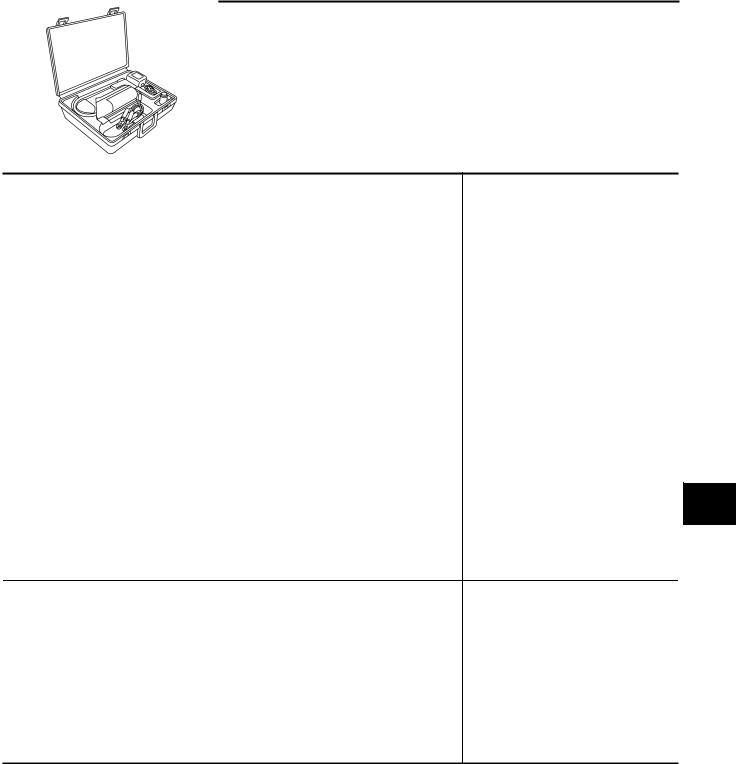
PREPARATION
HFC-134a (R-134a) Service Tools and Equipment |
AJS001O9 |
Never mix HFC-134a (R-134a) refrigerant and/or its specified lubricant with CFC-12 (R-12) refrigerant and/or its lubricant.
Separate and non-interchangeable service equipment must be used for handling each type of refrigerant/lubricant.
Refrigerant container fittings, service hose fittings and service equipment fittings (equipment which handles refrigerant and/or lubricant) are different between CFC-12 (R-12) and HFC-134a (R-134a). This is to avoid mixed use of the refrigerants/lubricant.
Never use adapters that convert one size fitting to another: refrigerant/lubricant contamination occurs and compressor malfunction may result.
A
B
C
Tool number |
|
(Kent-Moore No.) |
Description |
Tool name |
|
|
|
|
Container color: Light blue |
|
Container marking: HFC-134a (R- |
HFC-134a (R-134a) refrigerant |
134a) |
|
Fitting size: Thread size |
|
● Large container 1/2″ -16 ACME |
|
S-NT196 |
|
|
|
Type: Polyalkylene glycol oil (PAG), |
|
type S (DH-PS) |
Nissan A/C System Oil Type S |
Application: |
(DH-PS) |
HFC-134a (R-134a) wobble (swash) |
|
plate compressors (Nissan only) |
|
Capacity: 40 m (1.4 Imp fl oz) |
|
S-NT197 |
|
|
(ACR2005-NI) |
Function: Refrigerant recovery, |
ACR5 A/C Service Center |
recycling and recharging |
|
WJIA0293E |
(J-41995) |
Power supply: |
Electrical leak detector |
DC 12 V (Battery terminal) |
AHA281A
D
E
F
G
H
I
MTC
K
L
M
Revision: 2006 July |
MTC-13 |
2006 X-Trail |

PREPARATION
Tool number |
|
|
|
(Kent-Moore No.) |
|
|
Description |
Tool name |
|
|
|
|
|
|
|
(J-43926) |
|
|
|
Refrigerant dye leak detection kit |
|
|
|
Kit includes: |
|
|
|
(J-42220) |
|
|
|
UV lamp and UV safety goggles |
|
|
|
(J-41459) |
|
|
|
HFC-134a (R-134a) dye injector |
|
|
Power supply: |
Use with J-41447, 1/4 ounce |
|
|
|
|
|
DC 12 V (Battery terminal) |
|
bottle |
|
|
|
|
|
|
|
(J-41447) |
|
|
|
HFC-134a (R-134a) fluorescent |
|
|
|
leak detection dye |
|
|
|
(Box of 24, 1/4 ounce bottles) |
|
|
|
(J-43872) |
|
ZHA200H |
|
Refrigerant dye cleaner |
|
|
|
|
|
|
|
|
|
|
Power supply: |
|
|
|
DC 12 V (Battery terminal) |
(J-42220) |
|
|
For checking refrigerant leak when |
|
|
fluorescent dye is installed in A/C |
|
UV lamp and UV safety goggles |
|
|
|
|
|
system |
|
|
|
|
|
|
|
|
Includes: |
|
SHA438F |
|
UV lamp and UV safety goggles |
|
|
|
|
|
|
|
|
|
|
|
Application: |
|
|
|
For HFC-134a (R-134a) PAG oil |
(J-41447) |
|
|
Container: |
HFC-134a (R-134a) fluorescent |
|
|
1/4 ounce (7.4cc) bottle |
leak detection dye |
|
|
(Includes self-adhesive dye |
(Box of 24, 1/4 ounce bottles) |
|
|
identification labels for affixing to |
|
|
|
vehicle after charging system with |
|
SHA439F |
|
dye.) |
|
|
|
|
|
|
|
|
(J-41459) |
|
|
|
HFC-134a (R-134a) dye injector |
|
|
For injecting 1/4 ounce of fluorescent |
Use with J-41447, 1/4 ounce |
|
|
leak detection dye into A/C system |
bottle |
|
|
|
|
SHA440F |
|
|
|
|
|
|
(J-43872) |
|
|
For cleaning dye spills |
Refrigerant dye cleaner |
|
|
|
|
|
|
|
|
SHA441F |
|
|
|
|
|
|
|
|
|
Identification: |
(J-39183) |
|
|
● The gauge face indicates HFC-134a |
Manifold gauge set (with hoses |
|
|
(R-134a). |
and couplers) |
|
|
Fitting size: Thread size |
|
|
|
● 1/2″ -16 ACME |
|
|
RJIA0196E |
|
|
|
|
|
Revision: 2006 July |
MTC-14 |
2006 X-Trail |
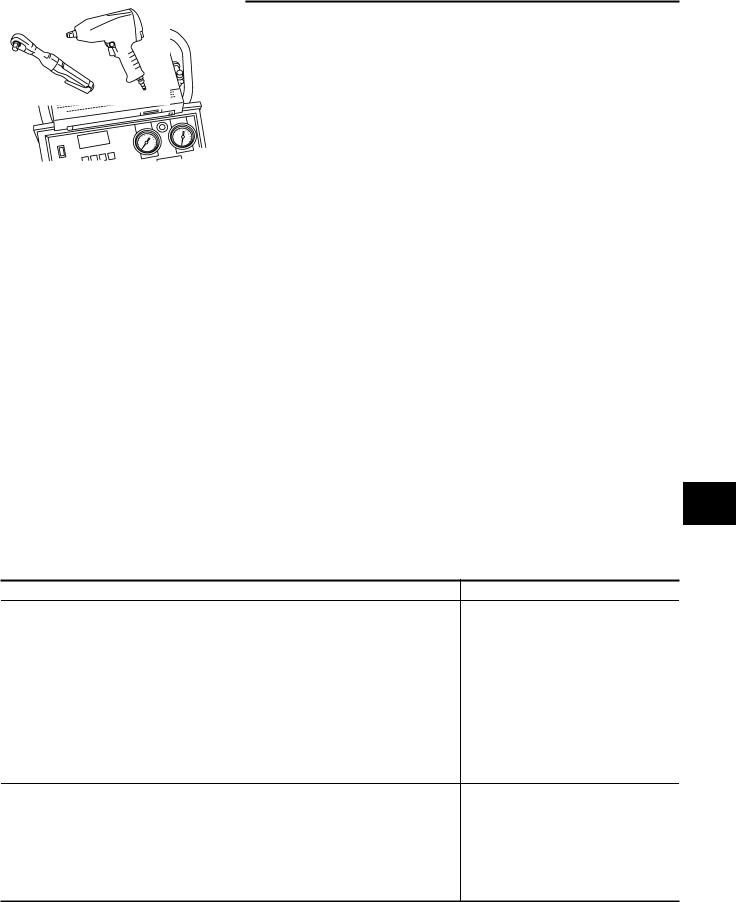
PREPARATION
|
Tool number |
|
|
|
(Kent-Moore No.) |
|
Description |
|
Tool name |
|
|
|
|
|
|
|
Service hoses |
|
Hose color: |
|
|
|
|
|
● (J-39501-72) |
|
● Low hose: Blue with black stripe |
|
|
|
|
|
High-pressure side hose |
|
● High hose: Red with black stripe |
|
● (J-39502-72) |
|
● Utility hose: Yellow with black stripe |
|
Low-pressure side hose |
|
or green with black stripe |
|
● (J-39476-72) |
|
Hose fitting to gauge: |
|
Utility hose |
S-NT201 |
● 1/2″ -16 ACME |
|
|
|
|
|
Service couplers |
|
|
|
● (J-39500-20) |
|
Hose fitting to service hose: |
|
High-pressure side coupler |
|
M14 x 1.5 fitting is optional or |
|
● (J-39500-24) |
|
permanently attached. |
|
|
|
|
|
Low-pressure side coupler |
|
|
|
|
S-NT202 |
|
|
|
|
|
|
(J-39650) |
|
For measuring of refrigerant |
|
|
Fitting size: Thread size |
|
|
Refrigerant weight scale |
|
|
|
|
1/2″ -16 ACME |
|
|
|
|
|
|
|
S-NT200 |
|
|
|
|
|
|
|
|
Capacity: |
|
(J-39649) |
|
● Air displacement: 4 CFM |
|
|
● Micron rating: 20 microns |
|
|
Vacuum pump |
|
|
|
|
● Oil capacity: 482 g (17 oz) |
|
|
(Including the isolator valve) |
|
|
|
|
|
Fitting size: Thread size |
|
|
S-NT203 |
1/2″ -16 ACME |
|
|
|
|
|
|
|
|
Commercial Service Tools |
|
AJS001OA |
|
A
B
C
D
E
F
G
H
I
MTC
K
Tool name |
Description |
L
M
Refrigerant identifier equipment
Checking for refrigerant purity and system contamination
RJIA0197E
Power tool |
For loosening bolts and nuts |
|
PBIC0190E |
Revision: 2006 July |
MTC-15 |
2006 X-Trail |
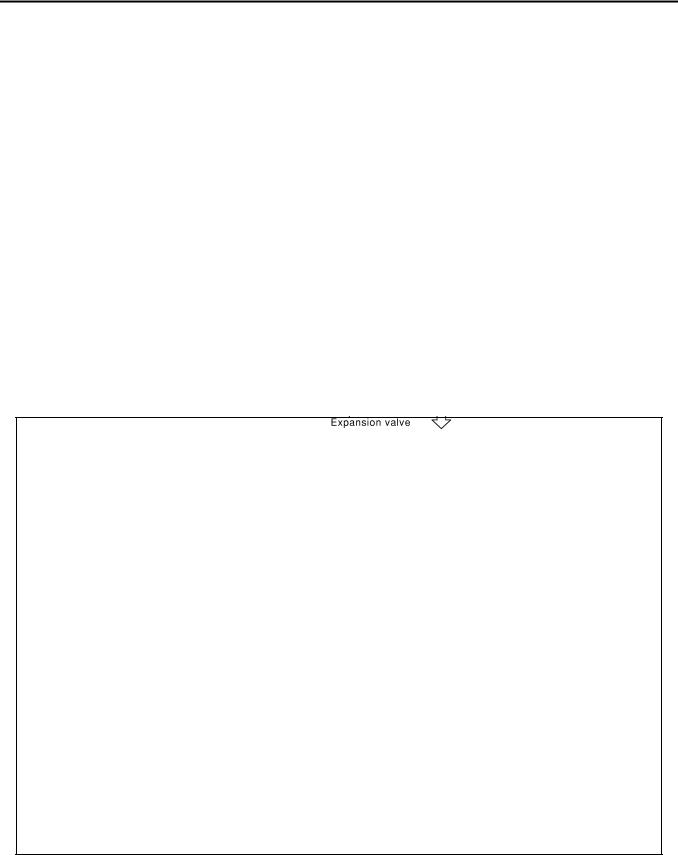
REFRIGERATION SYSTEM
REFRIGERATION SYSTEM
Refrigerant Cycle
REFRIGERANT FLOW
PFP:KA990
AJS001MG
The refrigerant flows from the compressor, through the condenser with liquid tank, through the evaporator, and back to the compressor. The refrigerant evaporation in the evaporator is controlled by an externally equalized expansion valve, located inside the evaporator case.
FREEZE PROTECTION
To prevent evaporator frozen up, the evaporator air temperature is monitored, and the voltage signal to the auto amp. will make the A/C relay go OFF and stop the compressor.
Refrigerant System Protection |
AJS001MH |
REFRIGERANT PRESSURE SENSOR
The refrigerant system is protected against excessively highor low-pressures by the refrigerant pressure sensor, located on the liquid tank. If the system pressure rises above, or falls below the specifications, the refrigerant pressure sensor detects the pressure inside the refrigerant line and sends the voltage signal to the ECM. ECM makes the A/C relay go OFF and stops the compressor when pressure on the high-pressure side
detected by refrigerant pressure sensor is over about 2,746 kPa (28 kg/cm2 , 398 psi), or below about 134 kPa (1.4 kg/cm2 , 20 psi).
PRESSURE RELIEF VALVE
The refrigerant system is also protected by a pressure relief valve, located in the rear head of the compressor.
When the pressure of refrigerant in the system increases to an unusual level [more than 3,727 kPa (38 kg/cm2 , 540 psi)], the release port on the pressure relief valve automatically opens and releases refrigerant into the atmosphere.
RJIA1552E
Revision: 2006 July |
MTC-16 |
2006 X-Trail |

REFRIGERATION SYSTEM
V-6 Variable Displacement Compressor |
AJS001MI |
GENERAL INFORMATION |
A |
1.The V-6 variable compressor differs from previous units. The vent temperatures of the V-6 variable com-
pressor do not drop too far below 5° C (41° F) when: |
|
|
Evaporator intake air temperature is less than 20° C (68° F). |
B |
|
Engine is running at speeds less than 1,500 rpm. |
|
|
This is because the V-6 compressor provides a means of “capacity” control. |
|
|
2. The V-6 variable compressor provides refrigerant control under varying conditions. During cold winters, it |
C |
|
may not produce high refrigerant pressure discharge (compared to previous units) when used with air |
||
|
||
conditioning systems. |
|
3.A “clanking” sound may occasionally be heard during refrigerant charge. The sound indicates that the tilt D angle of the wobble (swash) plate has changed and is not a malfunction.
4.For air conditioning systems with the V-6 compressor, the clutch remains engaged unless: the system
main switch, fan switch or ignition switch is turned OFF. When ambient (outside) temperatures are low or |
E |
when the amount of refrigerant is insufficient, the clutch is disengaged to protect the compressor. |
5.A constant range of suction pressure is maintained when engine speed is greater than a certain value. It
normally ranges from 147 to 177 kPa (1.5 to 1.8 kg/cm2 , 21 to 26 psi) under varying conditions. |
F |
In previous compressors, however, suction pressure was reduced with increases in engine speed. |
|
|
G |
|
H |
|
I |
|
|
|
MTC |
|
|
|
K |
|
L |
|
M |
Revision: 2006 July |
MTC-17 |
2006 X-Trail |

REFRIGERATION SYSTEM
DESCRIPTION General
The variable compressor is basically a swash plate type that changes piston stroke in response to the required cooling capacity.
The tilt of the wobble (swash) plate allows the piston’s stroke to change so that refrigerant discharge can be continuously changed from 13.5 to 146 cm3 (0.824 to 8.91 cu in).
SJIA0631E
Revision: 2006 July |
MTC-18 |
2006 X-Trail |

REFRIGERATION SYSTEM
Operation
1.Operation Control Valve
Operation control valve is located in the suction port (low-pressure) side, and opens or closes in response to changes in refrigerant suction pressure.
Operation of the valve controls the internal pressure of the crankcase.
The angle of the wobble (swash) plate is controlled between the crankcase’s internal pressure and the piston cylinder pressure.
2.Maximum Cooling
Refrigerant pressure on the low-pressure side increases with an increase in heat loads.
When this occurs, the control valve’s bellows compress to open the low-pressure side valve and close the high-pressure side valve.
This causes the following pressure changes:
●The crankcase’s internal pressure to equal the pressure on the low-pressure side;
●The cylinder’s internal pressure to be greater than the crankcase’s internal pressure.
Under this condition, the wobble (swash) plate is set to the maximum stroke position.
RHA473C
3.Capacity Control
●Refrigerant pressure on suction side is low during high speed driving or when ambient or interior temperature is low.
●The bellows expands when refrigerant pressure on the suction pressure side drops below approximately 177 kPa (1.8 kg/cm2 , 26 psi).
Since suction pressure is low, it makes the suction port close and the discharge port open. Thus, crankcase pressure becomes high as high-pressure enters the crankcase.
●The force acts around the journal pin near the wobble (swash) plate, and is generated by the pressure difference between before and behind the piston.
The drive lug and journal pin are located where the piston generates the highest pressure. Piston pressure is between suction pressure Ps and discharge pressure Pd, which is near suction pressure Ps. If crankcase pressure Pc rises due to capacity control, the force around the journal pin makes the wobble (swash) plate angle decrease and also the piston stroke decrease. In other words, crankcase pressure increase triggers pressure difference between the piston and the crankcase. The pressure difference changes the angle of the wobble (swash) plate.
A
B
C
D
E
F
G
H
I
MTC
K
L
M
Revision: 2006 July |
MTC-19 |
2006 X-Trail |
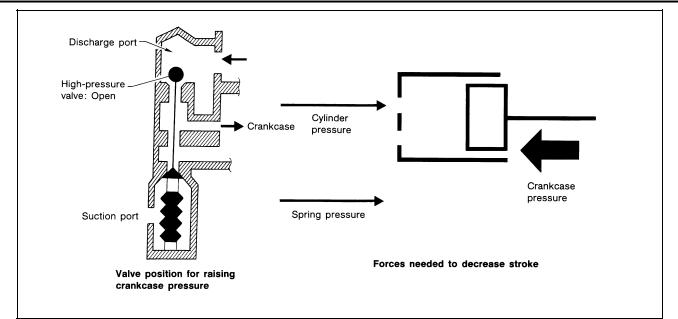
REFRIGERATION SYSTEM
RHA474C
Revision: 2006 July |
MTC-20 |
2006 X-Trail |
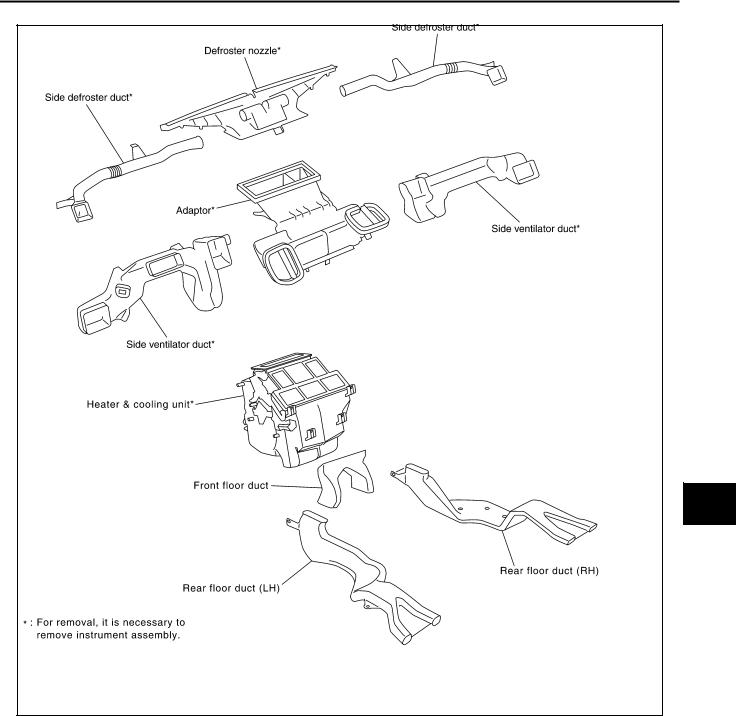
REFRIGERATION SYSTEM
Component Layout
AJS001MJ
A
B
C
D
E
F
G
H
I
MTC
K
L
M
RJIA3092E
Revision: 2006 July |
MTC-21 |
2006 X-Trail |

LUBRICANT
LUBRICANT
Maintenance of Lubricant Quantity in Compressor
PFP:KLG00
AJS001MK
The lubricant in the compressor circulates through the system with the refrigerant. Add lubricant to compressor when replacing any component or after a large refrigerant leakage occurred. It is important to maintain the specified amount.
If lubricant quantity is not maintained properly, the following malfunctions may result:
●Lack of lubricant: May lead to a seized compressor.
●Excessive lubricant: Inadequate cooling (thermal exchange interference)
LUBRICANT
Name |
: Nissan A/C System Oil Type S |
LUBRICANT RETURN OPERATION
Adjust the lubricant quantity according to the test group shown below.
1. CHECK LUBRICANT RETURN OPERATION
Can lubricant return operation be performed?
●A/C system works properly.
●There is no evidence of a large amount of lubricant leakage.
CAUTION:
If excessive lubricant leakage is noted, never perform the lubricant return operation.
OK or NG
OK |
>> GO TO 2. |
NG |
>> GO TO 3. |
2. PERFORM LUBRICANT RETURN OPERATION, PROCEEDING AS FOLLOWS
1.Start the engine, and set the following conditions:
–
–
–
–
–
Engine speed: Idling to 1,200 rpm A/C switch: ON
Blower speed: Max. position
Temp. control: Optional [Set so that intake air temperature is 25 to 30° C (77 to 86° F).] Intake position: Recirculation (REC)
2.Perform lubricant return operation for about 10 minutes.
3.Stop the engine.
>>GO TO 3.
3.CHECK REPLACEMENT PART
Should the compressor be replaced?
YES |
>> GO TO MTC-23, "LUBRICANT ADJUSTING PROCEDURE FOR COMPRESSOR REPLACE- |
|
MENT" . |
NO |
>> GO TO MTC-23, "LUBRICANT ADJUSTING PROCEDURE FOR COMPONENTS REPLACE- |
|
MENT EXCEPT COMPRESSOR" . |
Revision: 2006 July |
MTC-22 |
2006 X-Trail |

LUBRICANT
LUBRICANT ADJUSTING PROCEDURE FOR COMPONENTS REPLACEMENT EXCEPT COMPRESSOR
After replacing any of the following major components, add the correct amount of lubricant to the system. Amount of lubricant to be added:
|
Lubricant to be added to system |
|
|
Part replaced |
|
Remarks |
|
Amount of lubricant |
|||
|
m (Imp fl oz) |
|
|
|
|
|
|
Evaporator |
75 (2.6) |
— |
|
|
|
|
|
Condenser |
35 (1.2) |
— |
|
|
|
|
|
Liquid tank |
10 (0.4) |
— |
|
|
|
|
|
In case of refrigerant leak |
30 (1.1) |
Large leak |
|
|
|
||
— |
Small leak *1 |
||
|
*1: If the refrigerant leak is small, no addition of lubricant is needed.
A
B
C
D
E
LUBRICANT ADJUSTING PROCEDURE FOR COMPRESSOR REPLACEMENT
1.Before connecting recovery/recycling recharging equipment to vehicle, check recovery/recycling recharging equipment gauges. No refrigerant pressure should be displayed. If NG, recover refrigerant from equipment lines.
2.Connect recovery/recycling recharging equipment to vehicle. Confirm refrigerant purity in supply tank using recovery/recycling recharging equipment and refrigerant identifier. If NG, refer to MTC-5, "CONTAMINATED REFRIGERANT" .
3.Confirm refrigerant purity in vehicle A/C system using recovery/recycling recharging equipment and refrigerant identifier. If NG, refer to MTC-5, "CONTAMINATED REFRIGERANT" .
4.Discharge refrigerant into the refrigerant recovery/recycling equipment. Measure lubricant discharged into the recovery/recycling equipment.
5.Drain the lubricant from the old (removed) compressor into a graduated container and recover the amount of lubricant drained.
6.Drain the lubricant from the new compressor into a separate, clean container.
7.Measure an amount of new lubricant installed equal to amount drained from old compressor. Add this lubricant to new compressor through the suction port opening.
8.Measure an amount of new lubricant equal to the amount recovered during discharging. Add this lubricant
to new compressor through the suction port opening.
9.If the liquid tank also needs to be replaced, add another 5 m (0.2 Imp fl oz) of lubricant at this time. Do not add this 5 m
(0.2 Imp fl oz) of lubricant at this time. Do not add this 5 m (0.2 Imp fl oz) of lubricant when replaces the compressor only.
(0.2 Imp fl oz) of lubricant when replaces the compressor only.
F
G
H
I
MTC
K
L
M
Revision: 2006 July |
MTC-23 |
2006 X-Trail |

LUBRICANT
SJIA0596E
Revision: 2006 July |
MTC-24 |
2006 X-Trail |
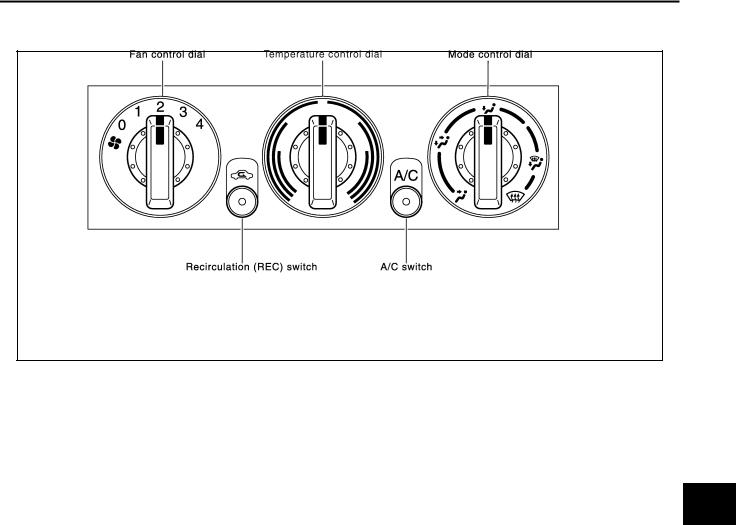
AIR CONDITIONER CONTROL
AIR CONDITIONER CONTROL
Control Operation
PFP:27500
A
AJS001ML
B
C
D
E
F
G
RJIA3132E
FAN CONTROL DIAL
This dial turns the fan ON and OFF, and controls fan speed.
TEMPERATURE CONTROL DIAL
This dial is to adjust the temperature of the discharge air.
MODE CONTROL DIAL
This dial controls the air flow outlet.
RECIRCULATION (REC) SWITCH
Recirculation (REC) position: Interior air is recirculated inside the vehicle. (The indicator lamp will illuminates.) Fresh (FRE) position: Outlet air is drawn into the passenger compartment. (The indicator lamp will not illuminates.)
A/C SWITCH
The A/C switch controls the air conditioner system. When the switch is depressed with the fan ON, the compressor will turn ON. The indicator lamp will also illuminates.
The air conditioner cooling function operates when the engine is running only.
H
I
MTC
K
L
M
Revision: 2006 July |
MTC-25 |
2006 X-Trail |
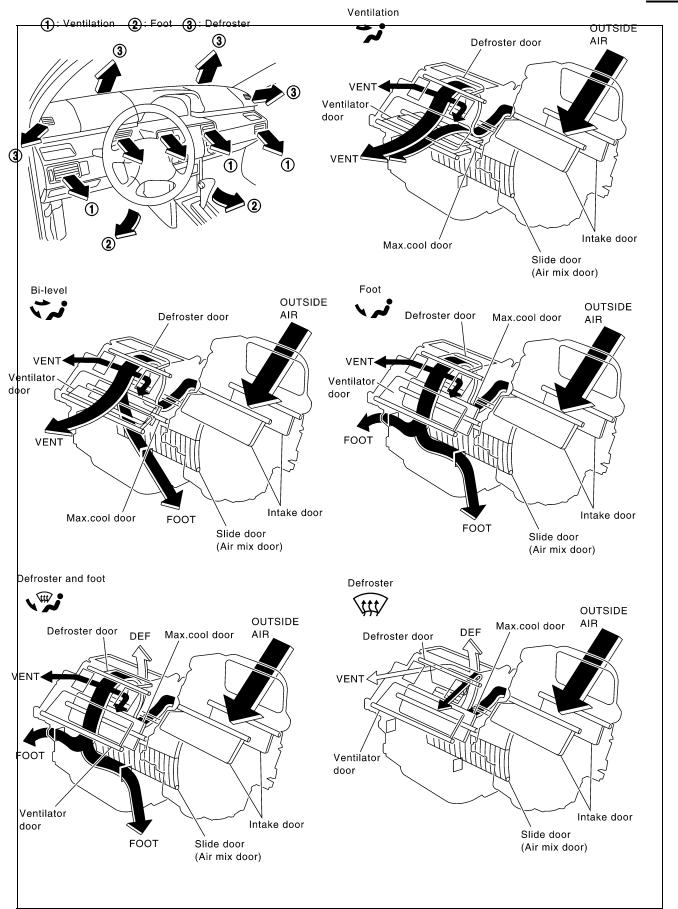
AIR CONDITIONER CONTROL
Discharge Air Flow
AJS001MM
SJIA0441E
Revision: 2006 July |
MTC-26 |
2006 X-Trail |

AIR CONDITIONER CONTROL
System Description
SWITCHES AND THEIR CONTROL FUNCTION
AJS001MN
A
B
C
D
E
F
G
H
I
RJIA3183E
MTC
K
L
M
RJIA0701E
Revision: 2006 July |
MTC-27 |
2006 X-Trail |

TROUBLE DIAGNOSIS
TROUBLE DIAGNOSIS
How to Perform Trouble Diagnoses for Quick and Accurate Repair
WORK FLOW
PFP:00004
AJS001MO
SHA900E
*1 MTC-36, "Operational Check"
SYMPTOM TABLE
Symptom |
Reference Page |
|
|
|
|
|
|
Air outlet does not change. |
Go to Trouble Diagnosis Procedure for Mode Door. |
MTC-37, "Mode Door" |
|
|
|
|
|
Discharge air temperature does not change. |
Go to Trouble Diagnosis Procedure for Air Mix Door. |
MTC-38, "Air Mix |
|
Door" |
|||
|
|
||
|
|
|
|
Intake door does not change. |
Go to Trouble Diagnosis Procedure for Intake Door Motor. |
MTC-39, "Intake Door |
|
|
|||
|
Motor Circuit" |
||
Intake door motor does not operate normally. |
|||
|
|||
|
|
||
|
|
|
|
Blower motor operation is malfunctioning. |
Go to Trouble Diagnosis Procedure for Blower Motor. |
MTC-42, "Blower |
|
Motor Circuit" |
|||
|
|
||
|
|
|
|
Magnet clutch does not engage. |
Go to Trouble Diagnosis Procedure for Magnet Clutch. |
MTC-46, "Magnet |
|
Clutch Circuit" |
|||
|
|
||
|
|
|
|
Insufficient cooling |
Go to Trouble Diagnosis Procedure for Insufficient Cooling. |
MTC-52, "Insufficient |
|
Cooling" |
|||
|
|
||
|
|
|
|
Insufficient heating |
Go to Trouble Diagnosis Procedure for Insufficient Heating. |
MTC-60, "Insufficient |
|
Heating" |
|||
|
|
||
|
|
|
|
Noise |
Go to Trouble Diagnosis Procedure for Noise. |
MTC-61, "Noise" |
|
|
|
|
Revision: 2006 July |
MTC-28 |
2006 X-Trail |
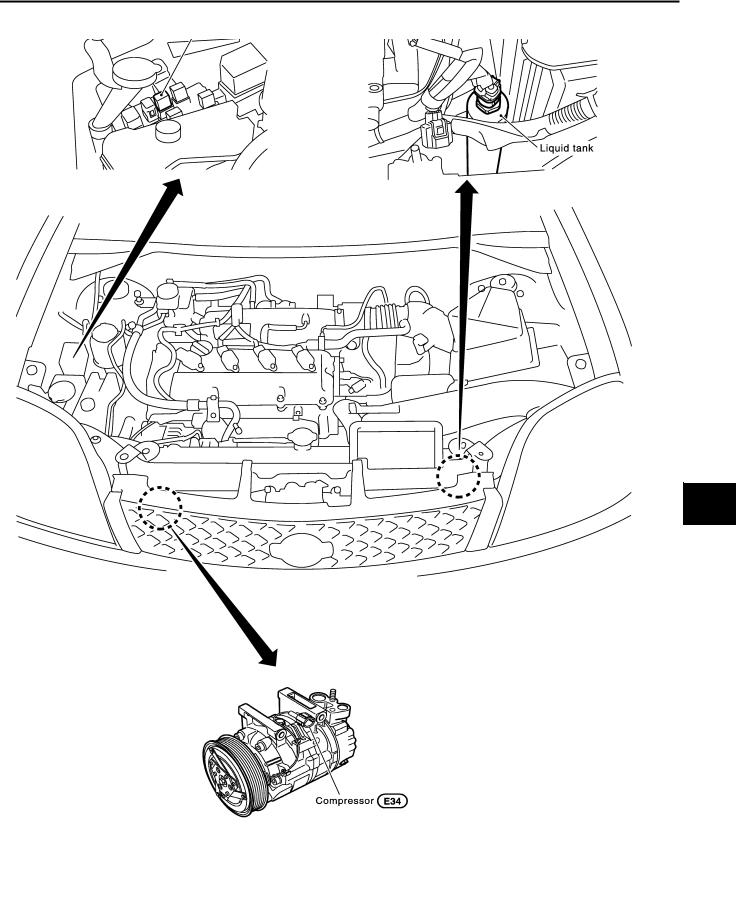
TROUBLE DIAGNOSIS
Component Parts and Harness Connector Location |
AJS001MP |
ENGINE COMPARTMENT |
A |
B
C
D
E
F
G
H
I
MTC
K
L
M
RJIA3133E
Revision: 2006 July |
MTC-29 |
2006 X-Trail |
